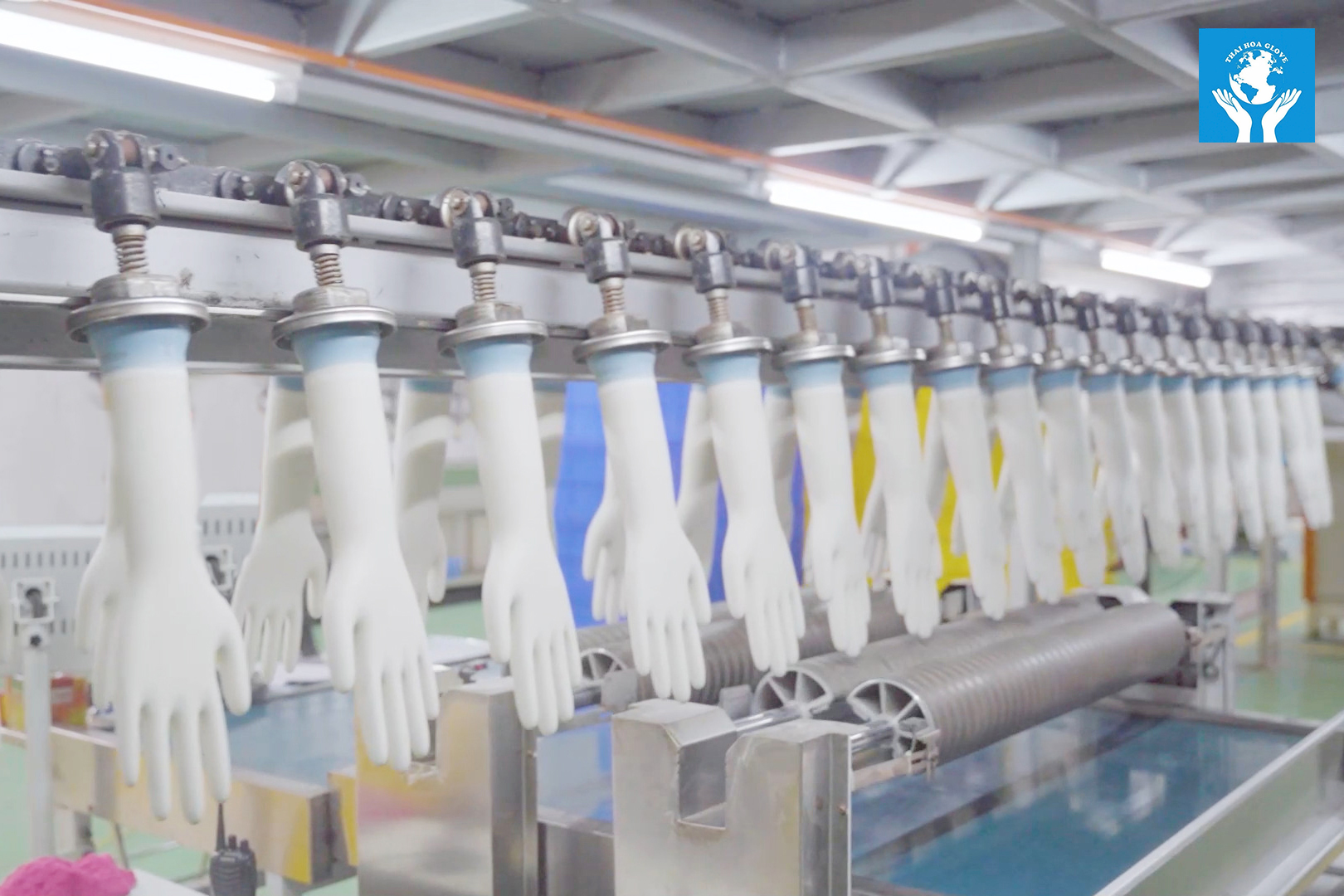Glove Forming Workshop: Realizing Cleanroom Products
Following the raw material processing, the glove forming workshop is where the carefully prepared polymer mixture is shaped into the initial form of complete cleanroom gloves. This is a crucial stage that demands high precision in every step to ensure the gloves’ dimensions, thickness, shape, and other physical properties meet technical requirements and quality standards. The forming workshop is equipped with modern machinery, strict operating procedures, and a team of skilled technicians to ensure product efficiency and quality.
1. Glove Mold Preparation:
Before the forming process begins, the glove molds – which determine the final shape of the product – must be carefully prepared. These molds are typically made of ceramic, aluminum, or other materials that can withstand heat and chemicals. The mold preparation process includes:
Mold Cleaning:
After each production cycle, glove molds must be thoroughly cleaned to remove polymer residue, dust, and other contaminants. The cleaning process may involve hot water washing, specialized chemical detergents, and the use of automated or semi-automated cleaning equipment.
Mold Inspection:
Once cleaned, the molds are carefully inspected to ensure their surfaces are free from cracks, scratches, or any damage that could affect glove quality. Defective molds are either removed from production or sent for maintenance.
Mold Heating:
The glove molds are typically preheated to a specific temperature before being dipped into the polymer mixture. Mold temperature affects the polymer’s adhesion and the thickness of the glove layer formed. The heating process is precisely controlled by an automated temperature control system.
2. Dipping Process:
This is the core stage in the glove forming workshop, where the glove’s initial shape is created:
Dipping into the Polymer Tank:
The preheated glove molds are dipped into a tank containing the liquid polymer mixture prepared in the raw material processing workshop. This dipping process is carried out using an automated conveyor system to ensure uniformity and consistency.
Control of Dipping Time and Speed:
The duration and speed at which the molds are dipped into the polymer tank are critical factors that determine the thickness of the glove layer. These parameters are precisely set and strictly monitored through an automated control system.
Coating Layer (Leaching – Optional):
For powdered latex gloves, some processes include dipping the molds into a calcium carbonate or talcum powder solution after the initial polymer dip. This coating helps the glove release more easily from the mold after vulcanization and reduces stickiness. For powder-free gloves, this step is skipped or replaced with alternative surface treatments to create a non-tacky finish.
Multiple Dipping Layers (Optional):
To achieve specific thickness or unique glove characteristics, certain glove types may undergo multiple dipping stages. These sequential dips can involve different polymer types for each layer to meet desired performance requirements.
3. Preheating (Initial Drying):
After dipping, the layer of liquid polymer adhering to the mold needs to be preheated to remove excess solvents and dry the surface before moving on to the vulcanization stage. This preheating process is typically carried out in drying ovens where temperature and duration are carefully controlled.
4. Vulcanization (Curing):
This is a crucial stage where cross-links are formed between polymer chains, providing the gloves with strength, elasticity, and essential physical properties:
Transfer to the Vulcanization Oven:
The pre-dried glove molds are transported into the vulcanization oven.
Temperature and Time Control:
The vulcanization temperature and duration are key factors determining glove quality. These parameters are precisely set and controlled automatically to ensure the vulcanization process is thorough and uniform across all gloves.
Final Shaping:
During vulcanization, the polymer layer on the mold transforms into an elastic glove film with a fixed shape conforming exactly to the mold.
5. Cooling:
After exiting the vulcanization oven, the glove molds and gloves need to be gradually cooled to prevent deformation caused by sudden temperature changes. The cooling process can occur naturally in the air or be assisted by cooling systems using fans or water.
6. Stripping/Doffing:
The vulcanized and cooled gloves are stripped off the molds. This process is usually carried out by automated or semi-automated equipment, using compressed air or mechanical mechanisms to gently detach the gloves from the molds without damaging the products.
7. Initial Quality Inspection:
After being stripped from the molds, the gloves undergo an initial quality inspection, which includes:
Visual Inspection: Assessing the shape, size, color, and surface for defects such as holes, tears, or other imperfections.
Size Measurement: Measuring the gloves to ensure compliance with technical standards.
Gloves that do not meet the requirements are rejected at this stage.
8. Transfer to the Next Workshops:
Gloves that pass the initial inspection are transferred to subsequent workshops to undergo processes such as washing, cleaning, surface treatment (if necessary), final quality inspection, and packaging.
Environmental and Safety Requirements:
The glove forming workshop must also comply with strict environmental and occupational safety standards:
Emission Control: The vulcanization process may produce emissions, so an efficient system for collecting and treating exhaust gases is necessary to prevent environmental pollution.
Machinery Operation Safety: Equipment in the forming workshop must be regularly maintained and equipped with safety measures to prevent workplace accidents. Operators must receive thorough training on operating procedures and safety protocols.
Temperature Control: The temperature in the vulcanization oven and working areas must be regulated to ensure comfortable and safe working conditions for employees.
Conclusion:
The glove forming workshop is a vital link in the cleanroom glove manufacturing chain. The integration of modern technology, strict process control, and a team of skilled personnel ensures that the carefully prepared polymer mixture is shaped into gloves with the precise form, size, and physical properties required by the stringent standards of cleanroom environments. The quality and efficiency of the forming workshop have a direct impact on both the productivity and the overall quality of the final product.



